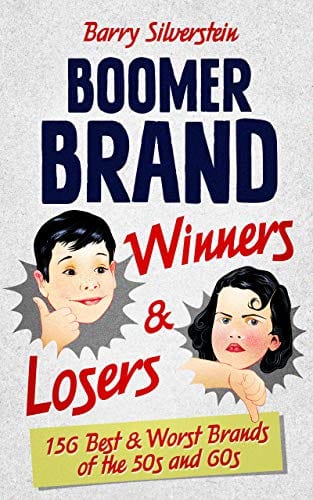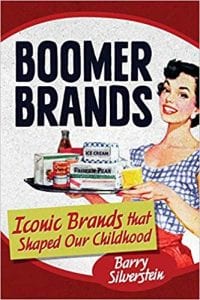Barry Silverstein’s Latest Book, “Boomer Brand Winners and Losers,” Is a Fun Read and a Walk Down Memory Lane
Perhaps all of us have moments when one of our more mundane thoughts crystalizes and remains frozen in our memory forever, though we don’t know why. I’ve had many of these over my lifetime. For example, during the 1962 Cuban Missile Crisis, I recall listening to the news on the radio in my mother’s kitchen, while I baked a cake which was destined to be that night’s dessert. I remember wondering whether or not Russian housewives had access to boxed cake mixes. And deciding they probably didn’t.
In an earlier memory – I couldn’t have been more than three or four – I remember lying on the couch in my parents’ living room, staring into sunbeams, and pondering cool inventions, like television. I recall wishing that I could invent something significant, thinking hard what that invention might be, and finally deciding that unfortunately, “everything had been invented already.”
This thought had to have come to me no later than 1955. And just think what has been invented since then!
How silly and innocent my thinking was! The list of post-midcentury inventions, is of course, way too long to list here. But here, in chronological order, are a bakers dozen notable inventions that immediately come to mind:
- The Skateboard, originally a counterculture “toy” used for riding and performing tricks, but which will become the required vehicle for a new Olympic sport in 2020 (Invented in 1959)

- Spandex, which was originally created for women’s girdles, but soon became a high fashion fabric. Who doesn’t remember stretch pants – especially the ones with stirrups? And who can forget biker shorts? (1959)
- The Miniskirt, the scandalously above-the-knee skirt made famous by fashion designers Mary Quant and Andre Courreges. How many of us Boomer girls wore them to school — only to have their length measured by teachers and principals? (early 1960s)
- The birth control pill. No doubt without this invention there would have been no sexual revolution. (1960)
- Author Ian Fleming’s James Bond character. Who hasn’t seen the movies launched by his books about a sexy, suave, British spy known as 007? (1962)
- The Beatles, the long-haired rock band that set off The British Invasion; their appearance on The Ed Sullivan show changed music forever. And don’t forget all the screaming, and fainting Boomer girls! (1964)
- The Ford Mustang, probably the first “muscle car” designed for – and affordable to – everyone. Introduced at the New York World’s Fair, unbelievably, 22,000 Mustang orders were taken the day they went on sale. And 418,812 sold the first year. (1964 1/2)
- Birkenstock sandals and Earth shoes, both big counterculture fashion successes. Ugly in the traditional fashion sense, but so comfortable. The Earth Shoe’s sole was thinner at the heel than the toe, which was supposed to be a more natural way to walk. (1964 and 1970, respectively)
- Pop-Tarts, that mass-produced toaster pastry whose sugary filling encased in two layers of pastry crust was enjoyed by so many kid Boomers. Who knew their name was influenced by Andy Warhol’s Pop Art movement? (1964)
- Gene Roddenberry’s iconic Star Trek science fiction television show that almost didn’t get off the ground, but eventually launched a franchise that still brings us new shows. (Star Trek Picard launched this month!) The USS Enterprise sold us all on the mission of “exploring new worlds and new civilizations. ” (1966)
- McDonald’s Big Mac. What Boomer hasn’t eaten – or at least heard thousands of commercials for – this fast food sandwich consisting of “two all-beef patties, special sauce, lettuce, cheese, pickles, onions on a sesame seed bun?” The iconic sandwich debuted in Pittsburgh, and went national the next year. Currently, an estimated 900 million Big Macs are sold annually around the globe. (1968)
- Frederick Wallace Smith’s Memphis-based overnight delivery company, FedEx, whose goal was simply to connect people with goods and services overnight. Unheard of concept when launched. Originally named Federal Express. (1971)
- The Mr. Coffee drip coffee maker which revolutionized how coffee was made. No more percolators which had to be heated on the stove meant we enjoyed reliable taste and consistency. (1972)
Just think what fun it would have been to have worked in marketing in the mid-60s – the era dramatized by the iconic TV series Mad Men – when nearly half the population of the United States was under age 25! (Remember, marketers understood Boomers, born between 1946 and 1964, were the largest and most influential demographic.) Influence no doubt helped along by the fact that we watched a lot of television. This was the time when television advertising developed, revolutionizing the way products and brands were marketed. The time when products “grew up” to become brands.
I could go on and on, recalling and listing brands and products that have been invented during our lifetimes — serendipitously, the time when the modern brand concept developed. Brands reflected popular culture and brand advertising flourished. But I don’t need to do this, since Barry Silverstein, a fellow Boomer who is also a brand historian, and brand marketing professional has written the book on Boomer Brands.
 Actually he’s written two books on this subject. His latest was just released this month: Boomer Brand Winners and Losers: 156 Best and Worst Brands of the 50s and 60s. In it, Silverstein considers not just traditional Boomer branded products – like cars, soft drinks and cereal – but also television shows, movies, songs, and personalities – noting all of them had an emotional impact on the Baby Boomer generation.
Actually he’s written two books on this subject. His latest was just released this month: Boomer Brand Winners and Losers: 156 Best and Worst Brands of the 50s and 60s. In it, Silverstein considers not just traditional Boomer branded products – like cars, soft drinks and cereal – but also television shows, movies, songs, and personalities – noting all of them had an emotional impact on the Baby Boomer generation.
Each chapter covers a brand genre, like “Toys, Games and Comic Books,” “Automobiles,” “Fast Food,” and “Snack Foods,” and “Soft Drinks.” Each chapter begins with a bit of an overview and then gets into the meat and potatoes of this book – a single page summary of each of the 156 brands reviewed. With each brand receiving a thumbs up or a thumbs down rating.
 This book is a great trip down memory lane. How long has it been since you thought about Lums restaurant, the VW Beetle, cap guns, Yogi Bear, the View Master toy, Maypo cereal, Three Mile Island or The Creature From the Black Lagoon? You’ll want to read the book so you can find out which brands get Silverstein’s thumbs up – or thumbs down – and decide if you agree with him.
This book is a great trip down memory lane. How long has it been since you thought about Lums restaurant, the VW Beetle, cap guns, Yogi Bear, the View Master toy, Maypo cereal, Three Mile Island or The Creature From the Black Lagoon? You’ll want to read the book so you can find out which brands get Silverstein’s thumbs up – or thumbs down – and decide if you agree with him.
And, don’t forget to check out Barry’s first book on Boomer Brands, “Boomer Brands: Iconic Brands That Shaped Our Childhood.”


